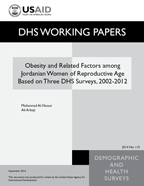
Abstract:
Objectives: The main objective of this study
is to analyze the trends in obesity among
Jordanian women of reproductive age over the
10-year period from 2002 to 2012 based on
three Demographic and Health Surveys (DHS).
Furthermore, the study aims to analyze the
possible factors predicting obesity among
Jordanian women.
Methodology: The individual and household
member data sets for each survey provided
data for ever-married and unmarried women,
respectively. The body mass index (BMI) of
each woman was calculated by dividing her
weight in kilograms by the square of her
height in meters. A binary variable
identifying women with BMI of 30 kg/m2 and
above as obese was used
throughout for descriptive, bivariate and
multivariate analyses. Two sets of analyses
were performed, one for all women and the
other for ever- married women only. Each set
of analyses covers the three DHS surveys,
which were conducted in 2002, 2009 and 2012.
For multivariate analysis, in addition to
three models of standard logistic regression
for individual surveys, we used a multi-level
fixed effect model for the pooled data.
Independent variables included age,
education, place of residence, wealth
quintiles and marital status. For the ever-
married sample additional variables related
to parity, use of contraceptive method,
smoking and working status were used. We used
STATA version 12 to consolidate the data sets
and the survey data analysis module in STATA
to perform descriptive
and multivariate analyses.
Results: No major differences in mean BMI or
the prevalence of obesity were observed among
women of reproductive age across the three
examined surveys. The mean BMI of the all-
women sample was approximately 27 kg/m2 for
the three surveys, while in the ever-married
sample it went was slightly higher, at 29
kg/m2. The prevalence of obesity for all
women ranged from 26.3 percent in 2002 to
28.7 percent in 2012. In the ever-married
women sample, the lowest prevalence of
obesity occurred in 2002, at 37.4 percent,
and the highest in 2009, at 38.9 percent. The
prevalence of obesity ranged across the
surveys from 8 percent to 13 percent for
never-married women and from 37 percent to 39
percent for ever-married women. Even after
adjustment for the age differences between
these groups, the never-married were less
likely to be obese than the ever-married.
 Obesity and Related Factors among Jordanian Women of Reproductive Age Based on Three DHS Surveys, 2002-2012 (PDF, 711K)
Obesity and Related Factors among Jordanian Women of Reproductive Age Based on Three DHS Surveys, 2002-2012 (PDF, 711K)
